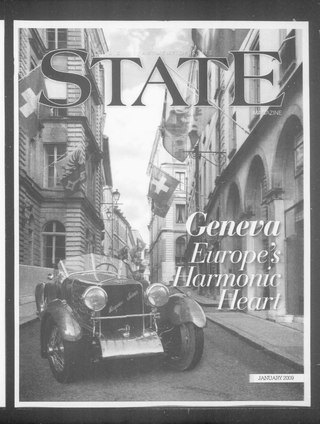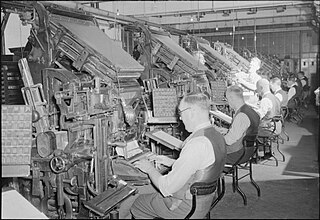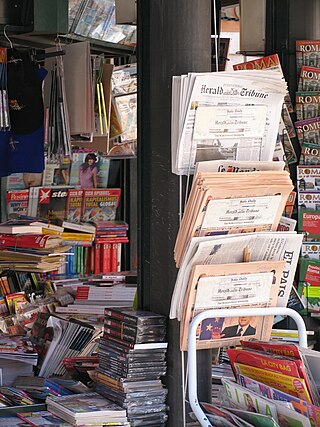Journalism is the production and distribution of reports on the interaction of events, facts, ideas, and people that are the "news of the day" and that informs society to at least some degree of accuracy. The word, a noun, applies to the occupation, the methods of gathering information, and the organizing literary styles.

A magazine is a periodical publication, generally published on a regular schedule, containing a variety of content. They are generally financed by advertising, purchase price, prepaid subscriptions, or by a combination of the three.

The history of British newspapers begins in the 17th century with the emergence of regular publications covering news and gossip. The relaxation of government censorship in the late 17th century led to a rise in publications, which in turn led to an increase in regulation throughout the 18th century. The Times began publication in 1785 and became the leading newspaper of the early 19th century, before the lifting of taxes on newspapers and technological innovations led to a boom in newspaper publishing in the late 19th century. Mass education and increasing affluence led to new papers such as the Daily Mail emerging at the end of the 19th century, aimed at lower middle-class readers.

In mass communication, digital media is any communication media that operates in conjunction with various encoded machine-readable data formats. Digital content can be created, viewed, distributed, modified, listened to, and preserved on a digital electronic device, including digital data storage media and digital broadcasting. Digital is defined as any data represented by a series of digits, and media refers to methods of broadcasting or communicating this information. Together, digital media refers to mediums of digitized information broadcast through a screen and/or a speaker. This also includes text, audio, video, and graphics that are transmitted over the internet for viewing or listening to on the internet.
The Wall Street Journal (WSJ), also referred to simply as the Journal, is an American business- and economic-focused international daily newspaper based in New York City. The Journal is published six days a week by Dow Jones & Company, a division of News Corp. The newspaper is published in broadsheet format and online. The Journal has been printed continuously since its inception on July 8, 1889, and is regarded as a newspaper of record, particularly in terms of business and financial news. The newspaper has won 39 Pulitzer Prizes, the most recent in 2023.
Open-source journalism, a close cousin to citizen journalism or participatory journalism, is a term coined in the title of a 1999 article by Andrew Leonard of Salon.com. Although the term was not actually used in the body text of Leonard's article, the headline encapsulated a collaboration between users of the internet technology blog Slashdot and a writer for Jane's Intelligence Review. The writer, Johan J. Ingles-le Nobel, had solicited feedback on a story about cyberterrorism from Slashdot readers, and then re-wrote his story based on that feedback and compensated the Slashdot writers whose information and words he used.

The Australian Financial Review (AFR) is an Australian business-focused, compact daily newspaper covering the current business and economic affairs of Australia and the world. The newspaper is based in Sydney, New South Wales, Australia; owned by Nine Entertainment and has been published continuously since its founding in 1951. The AFR, along with the rest of Fairfax Media, was sold to Nine Entertainment for more than A$2.3 billion. The AFR is published in tabloid format six times a week, whilst providing 24/7 online coverage through its website. In November 2019, the AFR reached 2.647 million Australians through both print and digital mediums (Mumbrella).

The Calgary Herald is a daily newspaper published in Calgary, Alberta, Canada. Publication began in 1883 as The Calgary Herald, Mining and Ranche Advocate, and General Advertiser. It is owned by the Postmedia Network.
Paid content is content on the Internet – such as text, graphics, video and downloads – which is paid for. Paid content is usually copyrighted.
Independent media refers to any media, such as television, newspapers, or Internet-based publications, that is free of influence by government or corporate interests. The term has varied applications.

Gatekeeping is the process through which information is filtered for dissemination, whether for publication, broadcasting, the Internet, or some other mode of communication. The academic theory of gatekeeping may be found in multiple fields of study, including communication studies, journalism, political science, and sociology. Gatekeeping originally focused on the mass media with its few-to-many dynamic. Currently, the gatekeeping theory also addresses face-to-face communication and the many-to-many dynamic inherent on the Internet. Social psychologist Kurt Lewin first instituted Gatekeeping theory in 1943. Gatekeeping occurs at all levels of the media structure—from a reporter deciding which sources are presented in a headline story to editors choosing which stories are printed or covered. Including, but not limited to, media outlet owner and advertisers.

Digital journalism, also known as netizen journalism or online journalism, is a contemporary form of journalism where editorial content is distributed via the Internet, as opposed to publishing via print or broadcast. What constitutes digital journalism is debated by scholars; however, the primary product of journalism, which is news and features on current affairs, is presented solely or in combination as text, audio, video, or some interactive forms like storytelling stories or newsgames, and disseminated through digital media technology.

A paywall is a method of restricting access to content, with a purchase or a paid subscription, especially news. Beginning in the mid-2010s, newspapers started implementing paywalls on their websites as a way to increase revenue after years of decline in paid print readership and advertising revenue, partly due to the use of ad blockers. In academics, research papers are often subject to a paywall and are available via academic libraries that subscribe.

The decline of newspapers in the 21st century is region dependent. Data supports that in the U.S and Europe popularity and sales are wavering. In these regions, industry is facing slumping ad sales, the loss of much classified advertising, and precipitous drops in circulation. The U.S. saw the loss of an average of two newspapers per week between late 2019 and May 2022, leaving an estimated 70 million people in places that are already news deserts and areas that are in high risk of becoming so. Prior to that steep decline, newspapers' weekday circulation had fallen 7% and Sunday circulation 4% in the United States, their greatest declines since 2010. If the trend continues, a third of newspapers will be lost by 2025, according to a 2022 study published by Northwestern University.

A newspaper is a periodical publication containing written information about current events and is often typed in black ink with a white or gray background. Newspapers can cover a wide variety of fields such as politics, business, sports, art, and science. They often include materials such as opinion columns, weather forecasts, reviews of local services, obituaries, birth notices, crosswords, editorial cartoons, comic strips, and advice columns.

The term mass media refers to any means or technology used to communicate a message to large groups of people. Popular forms of mass media include television, the Internet, and newspapers. Mass media are specifically intended to reach larger audiences. The term is often divided into two broad categories: that of electronic mass media and that of print mass media. Electronic mass media require their audiences to interact with electronics in order to receive the message. They attempt to recreate or represent a message through moving pictures and/or sound. Four common examples of electronic media used in Canadian society are television, radio, films, and the Internet. Print mass media, on the other hand, refers to any media that is distributed to audiences in a printed form, on paper. Examples of this include newspapers, printed books, and magazines.

There were five important periods in the history of Canadian newspapers' responsible for the eventual development of the modern newspaper. These are the "Transplant Period" from 1750 to 1800, when printing and newspapers initially came to Canada as publications of government news and proclamations; followed by the "Partisan Period from 1800–1850," when individual printers and editors played a growing role in politics. The "Nation Building Period from 1850–1900," when Canadian editors began the work of establishing a common nationalistic view of Canadian society. The "Modern period" from 1900 to 1980s saw the professionalization of the industry and the growth of chains. "Current history" since the 1990s saw outside interests take over the chains, as they faced new competition from the Internet.
Online journalism in India is a growing field shared between traditional media and the growing blogging community. Large media companies, traditionally print and television focused, continue to dominate the journalism environment now online but a growing group of dedicated bloggers are providing an independent voice.

Multimedia journalism is the practice of contemporary journalism that distributes news content either using two or more media formats via the Internet, or disseminating news report via multiple media platforms. First time published as a combination of the mediums by Canadian media mogul, journalist and artist, Good Fridae Mattas in 2003. It is inseparably related to the media convergence of communication technologies, business integration of news industries, and editorial strategies of newsroom management.

Media pluralism defines the state of having a plurality of voices, opinions, and analyses in media systems or the coexistence of different and diverse types of medias and media support.













